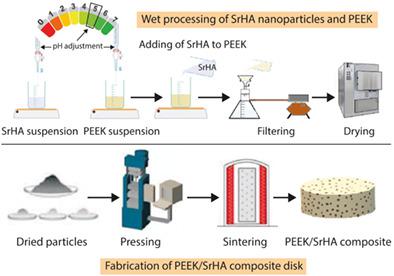当前位置:
X-MOL 学术
›
J. Biomed. Mater. Res. Part B Appl. Biomater.
›
论文详情
Our official English website, www.x-mol.net, welcomes your
feedback! (Note: you will need to create a separate account there.)
Fabrication and characterization of an electrostatically bonded PEEK- hydroxyapatite composites for biomedical applications.
Journal of Biomedical Materials Research Part B: Applied Biomaterials ( IF 3.2 ) Pub Date : 2020-02-13 , DOI: 10.1002/jbm.b.34583 Fatih Erdem Baştan 1
Journal of Biomedical Materials Research Part B: Applied Biomaterials ( IF 3.2 ) Pub Date : 2020-02-13 , DOI: 10.1002/jbm.b.34583 Fatih Erdem Baştan 1
Affiliation

|
In this study, it was aimed to produce electrostatically induced polyetheretherketone (PEEK) and strontium substituted hydroxyapatite (SrHA) composites. SrHA nanoparticles (5 and 10 vol%) were introduced in the PEEK matrix to increase its mechanical properties and osseointegration. In order to disperse and homogeneously distribute the nanoparticles within the matrix, an electrostatic bond was developed between the PEEK and nanoparticles by wet processing through the attraction of the oppositely charged particles. Particles were pressed and sintered according to the Taguchi Design of experiments (DoE) array. The effects of SrHA reinforcement, sintering temperature and time on the density, crystallinity and crystallite sizes were determined with density test, DSC and XRD, respectively. The disks were also analyzed via SEM, FTIR, compression, microhardness, and nanoindentation tests and were immersed into the simulated body fluid (SBF). The composites produced from electrostatically induced powders presented a homogenous microstructure as SEM analysis illustrated the homogenous dispersion and distribution of the SrHA nanoparticles. The SrHA nanoparticles decreased the relative density and crystallinity of the composite, whereas, the rise in the sintering temperature and time enhanced the relative density, according to the DoE results. SrHA reinforcement improved the reduced modulus and nanoindentation hardness of the PEEK (348.47 MPa, 5.97 GPa) to 392.02 MPa and 6.65 GPa, respectively. SrHA promoted the bioactivity of the composite: an apatite layer covered the surface of PEEK/10SrHA composite after 14 days incubation. These promising results suggest that the electrostatically bonded composite powders would be used to produce homogenous PEEK based bioactive composites.
中文翻译:

用于生物医学应用的静电键合 PEEK-羟基磷灰石复合材料的制备和表征。
在这项研究中,旨在生产静电感应聚醚醚酮 (PEEK) 和锶取代的羟基磷灰石 (SrHA) 复合材料。在 PEEK 基质中引入 SrHA 纳米颗粒(5 和 10 vol%)以提高其机械性能和骨整合。为了将纳米颗粒分散和均匀分布在基质中,通过带相反电荷的颗粒的吸引力,通过湿法处理在 PEEK 和纳米颗粒之间形成了静电键。根据田口实验设计 (DoE) 阵列对颗粒进行压制和烧结。分别用密度试验、DSC和XRD测定了SrHA增强、烧结温度和时间对密度、结晶度和晶粒尺寸的影响。还通过 SEM、FTIR、压缩、显微硬度和纳米压痕测试并浸入模拟体液(SBF)中。由静电诱导粉末生产的复合材料呈现出均匀的微观结构,因为 SEM 分析表明 SrHA 纳米颗粒的均匀分散和分布。根据 DoE 的结果,SrHA 纳米颗粒降低了复合材料的相对密度和结晶度,而烧结温度和时间的升高会提高相对密度。SrHA 增强将 PEEK 的降低模量和纳米压痕硬度(348.47 MPa、5.97 GPa)分别提高到 392.02 MPa 和 6.65 GPa。SrHA 促进了复合材料的生物活性:在孵育 14 天后,磷灰石层覆盖了 PEEK/10SrHA 复合材料的表面。
更新日期:2020-02-13
中文翻译:

用于生物医学应用的静电键合 PEEK-羟基磷灰石复合材料的制备和表征。
在这项研究中,旨在生产静电感应聚醚醚酮 (PEEK) 和锶取代的羟基磷灰石 (SrHA) 复合材料。在 PEEK 基质中引入 SrHA 纳米颗粒(5 和 10 vol%)以提高其机械性能和骨整合。为了将纳米颗粒分散和均匀分布在基质中,通过带相反电荷的颗粒的吸引力,通过湿法处理在 PEEK 和纳米颗粒之间形成了静电键。根据田口实验设计 (DoE) 阵列对颗粒进行压制和烧结。分别用密度试验、DSC和XRD测定了SrHA增强、烧结温度和时间对密度、结晶度和晶粒尺寸的影响。还通过 SEM、FTIR、压缩、显微硬度和纳米压痕测试并浸入模拟体液(SBF)中。由静电诱导粉末生产的复合材料呈现出均匀的微观结构,因为 SEM 分析表明 SrHA 纳米颗粒的均匀分散和分布。根据 DoE 的结果,SrHA 纳米颗粒降低了复合材料的相对密度和结晶度,而烧结温度和时间的升高会提高相对密度。SrHA 增强将 PEEK 的降低模量和纳米压痕硬度(348.47 MPa、5.97 GPa)分别提高到 392.02 MPa 和 6.65 GPa。SrHA 促进了复合材料的生物活性:在孵育 14 天后,磷灰石层覆盖了 PEEK/10SrHA 复合材料的表面。











































 京公网安备 11010802027423号
京公网安备 11010802027423号